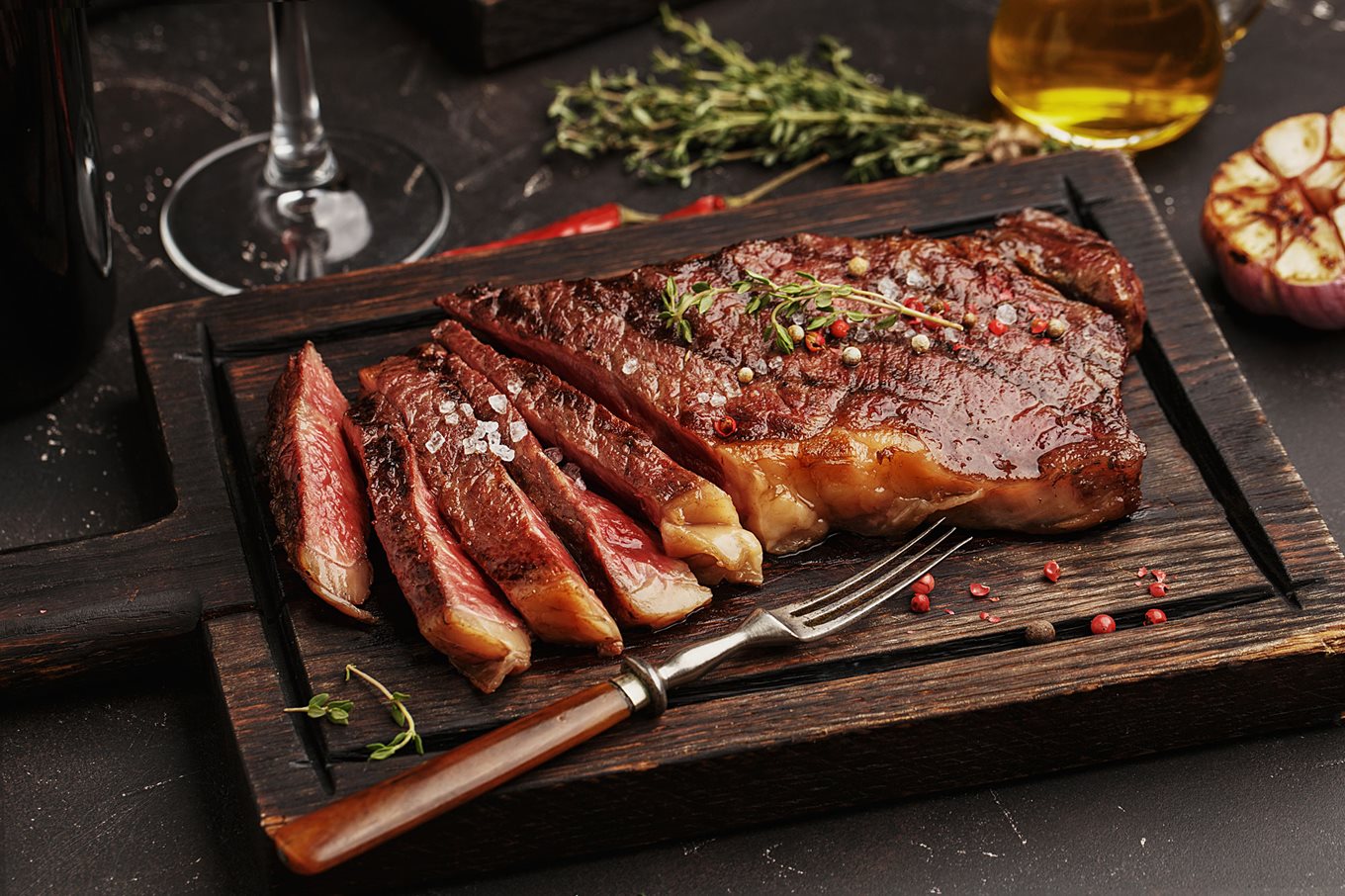


TONY BIGGS
Director of culinary arts,
Certified Angus Beef ® brand
What should an F&B manager of a restaurant or hotel look for when purchasing meat?
Choose a brand that’s recognized for having a great reputation, core values and experts to guide you. Of course, taste and flavor come along with it. When you put an item on your menu, make sure you have accessibility to that cut and trusted quality for consistency on each plate.
How can you identify premium-quality meat?
Most chefs understand USDA grades for prime and choice. The more marbling, the higher the quality. With Certified Angus Beef®, superior marbling is required for flavor, juiciness and tenderness.
What are the latest trends in cooking meat?
Everyone knows strip, filet and ribeye. Chefs worldwide are turning to secondary cuts: sirloin flap, tri-tip, chuck and round items. These cuts are affordable, a canvas for different ingredients and techniques, and popular with guests. Chefs coming to our culinary center get excited about the new dishes they can serve.
In an age of veganism, how do you explain consumers’ ongoing love affair with meat?
There’s a cherished heritage in the U.S. for raising and enjoying high-quality beef, and in our world today, it’s more accessible than ever before. Beef has a unique flavor and appeal that consumers crave. I have traveled extensively and found chefs rely on Certified Angus Beef® because of consistency and guest satisfaction.
What is your favorite brand of meat?
The Certified Angus Beef® brand. I started serving it when I worked for the Jordanian royal family. Because of great marbling, consistency and taste, it was a firm favorite. It unites family farmers with trusted distributors and chefs.

FRANK BORDONI
Head of food, Alshaya Group
What should an F&B manager of a restaurant or hotel look for when purchasing meat?
Always make sure the meat is firm and cold with no odor. The grain of the fibers will tell you whether the meat is likely tough or tender. Look for smooth cuts, as this is a sign it is butchered properly.
How can you identify premium-quality meat?
Look out for a fine meat grain, fewer muscle groups within the cut (a single muscle is best) and as little connective tissue as possible. There should be a lean to medium amount of fat marbling and a dry darker oxidized surface color that indicates it has been aged.
What are the latest trends in cooking meat?
Sous vide steak seems to be the hottest trend. Poaching the steak in a bag at 54 degrees for two hours breaks down the collagen and proteins to give an even cook. However, I would always recommend a reverse sear to invoke the Maillard reaction to bring out the color and distinct flavor of the meat.
In an age of veganism, how do you explain consumers’ ongoing love affair with meat?
Meat is traditionally perceived to be a highly valued food. It’s a staple ingredient in its simplest form and a luxury treat at its most premium. Variations in types of meat, cuts and cooking methods also make it possibly one of the most versatile food choices.
What is your favorite brand of meat?
I always go for quality and provenance; this is more important than the variety, breed or brand of meat. I want know about the animal, farm, its welfare and aging. As a self confessed carnivore, I love all meats, but beef is definitely my favorite. I can’t resist a rare roasted rib of beef on the bone served with Yorkshire pudding.

RABIH FOUANY
Head chef, InterContinental Phoenicia Beirut
What should an F&B manager of a restaurant or hotel look for when purchasing meat?
Meat quality is normally assessed by compositional quality and palatability factors, such as appearance, smell, firmness, juiciness, tenderness and flavor.
What are the latest trends in cooking meat?
Injecting meat before smoking or barbecuing is trendy. Injecting brisket, short rib or any other large piece of meat is the method of delivering salt, fats, seasonings and other flavors straight into the core of the meat. This technique helps to tenderize the meat while smoking and slow cooking keeping the moisture locked in. Cooking under ground level is also something we are seeing more and more. Mandi, a traditional Yemeni dish, is prepared by digging a pit, burning charcoal in it and layering spiced rice with marinated lamb, allowing it to slow cook for hours. The meat becomes very tender, light and juicy.
In an age of veganism, how do you explain consumers’ ongoing love affair with meat?
We all know that eating meat helped our ancestors survive. Today, we eat meat on most holidays. Some of us actually have genes that make us more likely to eat a lot of meat. Furthermore, eating meat is often part of our culture, history and psychology.
What is your favorite brand of meat?
Wagyu beef from Japan is deemed to be one of the best meats in the world. The marbled fat, diet of the animals and the way they are reared result in meat that’s unique in texture and taste. Black Angus is a Scottish breed of cow, which is also famous for its deep marbling. In addition, my favorite beef cuts are ribeye and short ribs.

THOMAS A. GUGLER
President, TAG Global and Worldchefs
What should an F&B manager of a restaurant or hotel look for when purchasing meat?
Quality is key. Wherever possible, reputable local brands should be chosen in order to demonstrate sustainability and to support domestic production.
How can you identify premium-quality meat?
The main things to look out for are marbling and texture. Color and smell follow.
What are the latest trends in cooking meat?
The best way to prepare meat is to create your own seasonings. An evergreen is great in the slow cooking process, which can tenderize any kind of meet to succulence and outstanding softness.
In an age of veganism, how do you explain consumers’ ongoing love affair with meat?
I believe it is based on history. Yes, it is true that veganism is a trend, but at the same time it’s a personal choice. I think it is important to respect both sides. With regards to sustainability and how to make the world a better place, reducing our consumption of meat is important.
What is your favorite brand of meat?
The world’s best meat brands are the types that are produced with utmost care, dedication and attention to the welfare of the animals. It is not related to a specific brand; the key is the proper set up of the growing process with the right staples.

TAREK IBRAHIM
Master chef , Meat & Livestock Australia
What should an F&B manager of a restaurant or hotel look for when purchasing meat?
Number one, the most important point, is that we have to work with a reputable country and a reputable company. Also, you need to think about what you will do with this meat. We should not follow trends blindly. For example, some people would recommend you to buy grass-fed or greenfed meat, but it all depends on how you intend to use it.
Furthermore, you have to be aware of the meat quality. When I am ordering grain-fed meat, I look for milky fat. If it is yellowish, that indicates that the meat is old or grassfed. Paying attention to the color of the meat is fundamental. If the meat is delivered fresh or chilled, it will be dark to begin with and turn rosy within a couple of minutes; if it is frozen, it needs to be placed in the cooler for at least two days. It is also important to understand cuts. Each piece of the animal needs to be treated differently.
What are the latest trends in cooking meat?
After 16 years of me preaching that there are meats beyond the tenderloin and the entrecote (rib-eye), I am happy to see a trend in non-loin cuts, including lump, shoulder, rump, skirt and others. Also the cooking method has changed. Nowadays, people are slow cooking: smoking the meat rather than grilling it. We are seeing a greater number of restaurants investing in machines to smoke meat. In addition, old recipes such as brisé are making a comeback.
In an age of vegetarianism and veganism, how do you explain consumers’ ongoing love affair with meat?
Veganism started a long time ago, but this trend is unlikely to affect the consumption of meat. Animal proteins have different sources. If one doesn’t consume meat because of health or religious concerns, it is understandable. Brands selling meat substitutes should focus on the nutritional value of their products. Whatever they do, they will never be able to replicate the real thing; there is always going to be a big difference between meat and meat substitutes.
What is your favorite brand of meat?
I personally adore the brands Stockyard and Jack’s Creek; receiving a package from these two brands fills me with great joy because their meat is top quality. I strongly believe that the meat’s flavor has to be optimal. Even the meat sauce, which should be cooked with the meat’s fond, needs to be placed on the side rather than on top of the meat. This allows customers to taste the dish properly. I personally prefer to present the meat alone and place the sides on a separate plate.

GERMÁN NAVARRETE
Corporate chef, USMEF
What should an F&B manager of a restaurant or hotel look for when purchasing meat?
Whenever you face the challenge of choosing beef, it is important to bear in mind that there are various aspects to consider in order to make sure you have the best quality and attributes that only U.S. beef can provide:
– The color of the meat must be bright red if it is not vacuum packed.
– If the meat is vacuum packed, it is important to open up the wrapping and let it oxygenate until it turns bright red. The amount of time depends on the weight and size of the piece.
– The package must be intact, with no scratches or tears.
– If it is not frozen, the internal temperature must not exceed 4 degrees. If it is frozen, it must be -18 degrees.
– If thawing is necessary, it must be carried out in the refrigerator, bearing in mind that seven hours are required for every two pounds of meat.
– Once thawed, the meat must be firm.
How can you identify premium-quality meat?
In the U.S. beef production system, animals are fed with corn toward the end of their lives. This ensures an important accumulation of intramuscular fat called marbling. This marbling can be easily appreciated in every muscle and depending on the amount, the meat is classified as follows: slight marbling is known as SELECT; moderate marbling is known as CHOICE; and abundant marbling is called PRIME. The three categories guarantee high quality. However, the more marbling there is on the meat, the greater its juiciness, flavor and tenderness.
The nutritional value of U.S. beef is extremely high. Humans can easily and immediately assimilate the iron content, which is not the case for many other iron sources.
In an age of vegetarianism and veganism, how do you explain consumers’ ongoing love affair with meat?
There’s no doubt that people will be tempted to try meat substitutes at some point in their lives. Nevertheless, it has been proven that our love affair with meat goes back many centuries.
Beef plays an important role as the center of the protein plate of choice. Proof of this can be found in any menu from any part of the world, with only a few exceptions.
What is your favorite brand of meat?
U.S. beef provides a wonderful and consistent experience for chefs, consumers and anyone involved in the process of enjoying a juicy, tender and flavorful piece of meat.
















